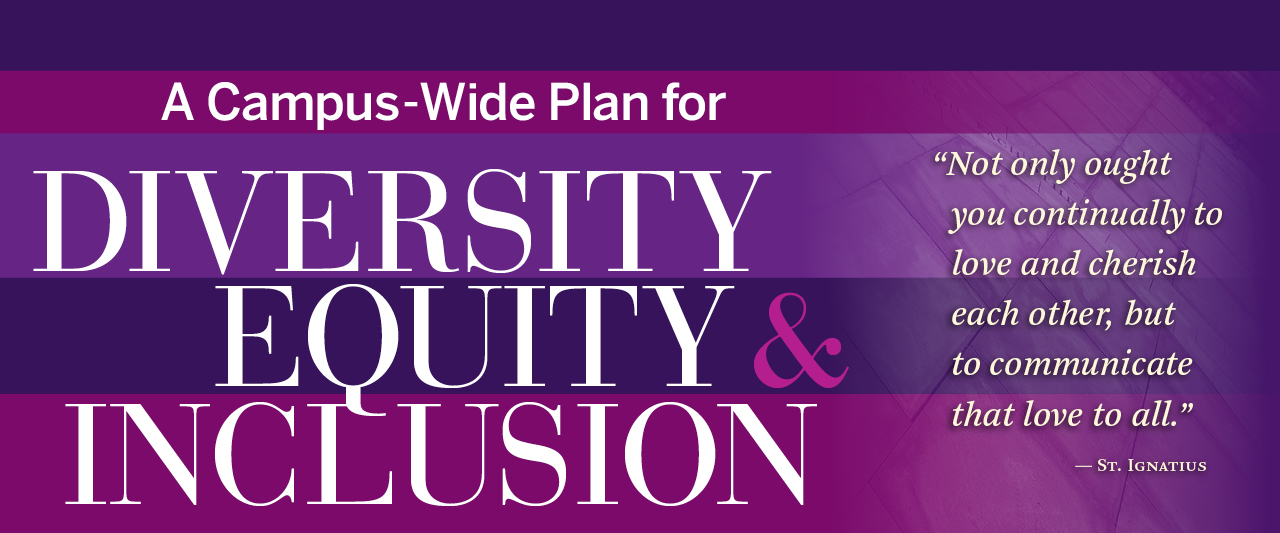Overall Findings
Institutional Commitment, Transparency, Accountability and Coordination
Initiatives and communications from the Offices of the President, Provost, and Equity and Diversity reflect a commitment to creating a more diverse and inclusive campus. Our Catholic, Jesuit mission is a strong frame of reference for many activities. University colleges, departments, divisions, committees and student groups have worked to increase engagement, education and dialogue; however, there opportunities to improve communications and collaboration. Evaluation and assessment of diversity and inclusion experiences, programming, and accountability for outcomes, is not centralized or systematically reviewed in a cross-divisional manner. A more sustainable, regular cycle for gathering input from current students – including graduate and online students - and employees is recommended, in addition to expanded outreach to our alumni. And, while data about campus diversity is routinely collected, it is not widely accessible to or actively shared with the campus community. Traditional communication venues and modalities should be revisited to ensure effective and impactful sharing of information to the campus community.
The Student Experience
The University has a variety of resources and programming that focuses heavily on advocacy, education and support. It demonstrates a mission-based commitment to improve current campus initiatives and create programming that supports students. However, gaps remain regarding engagement and support for historically underrepresented and underserved populations, and assessment data suggest opportunities to expand student engagement with persons different from themselves. Students advocate for and support one another through their leadership, clubs and organizations. The University does not currently have a formalized process for meeting with students that leave the University prior to graduation to identify why they chose to leave, and should prioritize this data gathering and analysis to understand and mitigate challenges.
The Academic Experience
Academic Affairs continues to sustain the work of diversity and inclusion in the classroom; however, there are many opportunities for the University to make strides to improve academic life and curriculum and expand support for faculty in order to infuse diversity and inclusion in support of the University’s mission. Current efforts to review the general education curriculum, growth in the Humanities, community and other partnerships, and faculty training and pedagogy development programming, are rich areas for exploring diversity and inclusion. Of particular importance is assuring equity of access to academic and learning support resources for all students. Educational assessment processes should examine outcomes and consider issues of diversity and inclusion.
The Faculty and Staff Experience
Student Recruitment, Enrollment, and Retention
Work is underway to increase diversity in student enrollment, and expand data analysis to better understand student attrition and retention trends. A number of departments and groups continue to discuss how to expand access to a Scranton education for those from underrepresented and underserved demographics. However, our inquiry suggests that divisions and departments are working on similar issues independently, and that more proactive sharing and discussion of student retention and attrition data with student support offices is needed. Information provided to potential students regarding campus diversity and inclusion is shared via general campus web sites, with little specific targeted information via admissions and program sub-sites.
Alumni and Community Engagement
The University engages with the local and regional community, through public lecture and dialogue events, service contributions to local groups and populations, community-based learning and research, and other educational programming. These connections are made by individual departments and programming areas, with some coordination across areas. Alumni connections are expanding through programming like the Rainbow Royals group, though assessment of alumni attitudes, outcomes, and experiences with diversity and inclusion as students and in their lives after Scranton is not conducted or used in a regular manner.






